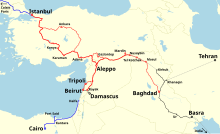Taurus Express
The Taurus Express ( Turkish Toros Ekspresi ) was an international express train from 1930 that connected Turkey , Syria and Iraq . From 1982 to 2008, a domestic Turkish long-distance train ran between Istanbul and Gaziantep under this name .
Lines
Initially, the train ran from Istanbul-Haydarpaşa via Konya , i.e. over the entire length of the Baghdad Railway , from 1935, after the connection from Boğazköprü on the Ankara - Sivas to Ulukışla line on the Baghdad Railway was completed, the Taurus Express ran via the new Turkish railway Capital and no longer about Konya. Since 1999 at the latest, the now only domestic Turkish connection has been routed again via Konya.
history
The Taurus Express was named after the Taurus Mountains , which it crosses on the Baghdad Railway in a technically complex way . The train ran for the first time on February 15, 1930, and in terms of timetables, the connection to the Simplon-Orient-Express was made in Istanbul by ferry across the Bosporus . In Aleppo the train was divided, some of the cars ran to Rayak , where there was a connection via the Lebanon Railway to Damascus and Beirut . Haifa could also be reached by bus . From Haifa there was a continuous rail connection with the “Cairo Express” to Cairo , which also carried a CIWL sleeping car.
The other part of the train drove from Aleppo over the Cenup Demiryolları route along the Turkish-Syrian border to Nusaybin . Passengers to Baghdad still had to change cars between Nusaybin and Kirkuk for two days. From Kirkuk the journey on the meter-gauge railway to Baghdad was continued. The continuous rail track was not completed until 1940. On July 17, 1940, the train was able to run continuously for the first time. In 1960 a shortcut route within Turkey was completed via Gaziantep . Since then, the detour via Aleppo for the train part to Baghdad was no longer necessary.
Due to political tensions, the train has only operated as a domestic Turkish connection since 1982. Between 2001 and the Second Gulf War in 2003, a weekly pair of trains is said to have passed the Mardin - Mosul - Baghdad route . Until 2008, the Taurus Express ran three times a week between Istanbul-Haydarpaşa and Gaziantep.
offer
The passing through coaches were originally provided by the Compagnie Internationale des Wagons-Lits (CIWL). Under their direction there were through car runs from Muslimiye via Aleppo to Rayak , where there was a connection to the Lebanon Railway to Damascus . Later there were also through cars that were carried from Aleppo to Tripoli and Beirut . The CIWL gave up the last of these services in 1972. Most recently, the train ran a through car from Istanbul to Aleppo and back once a week . This through car was still running on the entire Istanbul - Aleppo route at the end of December 2007 and has been permanently discontinued since June 2008.
future
In 2002, an agreement between the Turkish and Iraqi railways decided to resume the direct connection from Istanbul to Baghdad. However, the Third Gulf War and then the civil war in Syria have prevented this plan from being implemented until now. The Taurus Express within Turkey was discontinued by the TCDD in June 2008 on the grounds of long-term construction work and operations have not been resumed since then.
reception
The train found its most famous literary expression in the works of Agatha Christie . Starting in 1928, she traveled several times from Great Britain with the Orient Express to Istanbul and with the Taurus Express to Syria, where her second husband, the well-known archaeologist Max Mallowan , led excavations. She describes her travel experiences in her autobiography “ Come, tell me how you live ” (“ Remembering happy days ”), published in 1946 , and she processed them in some of her novels. Among other things, the novel Murder on the Orient Express begins here : The red kimono , now better known as Murder on the Orient Express .
Web links
- To the Orient, in one go . Report by Klaus Hillenbrand in the taz from July 16, 2005
literature
- Benno Bickel: With Agatha Christie through the gorges of the Taurus. The Baghdad Railway in the mirror of literature and travelogues. in: Jürgen Franzke (Hrsg.): Bagdadbahn and Hedjazbahn. German railway history in the Middle East. Tümmel, Nürnberg 2003, pp. 120–124. ISBN 3-921590-05-1 .
- Benno Bickel: Full steam ahead through the desert. Locomotive and operating history of the Hedjazbahn and Baghdadbahn. in: Jürgen Franzke (Hrsg.): Bagdadbahn and Hedjazbahn. German railway history in the Middle East. Tümmel, Nürnberg 2003, pp. 139–143. ISBN 3-921590-05-1 .
- Benno Bickel: Baghdad Railway Timeline. in: Jürgen Franzke (Hrsg.): Bagdadbahn and Hedjazbahn. German railway history in the Middle East. Tümmel, Nürnberg 2003, pp. 160–162. ISBN 3-921590-05-1 .
Individual evidence
- ↑ trains-worldexpresses.com: Chronology Middleeast Trains , accessed June 11, 2019
- ↑ This through car was temporarily listed in the timetables as running to Damascus , but this was never the case (source: information from the Syrian Railway on the occasion of an excursion by the German Society for Railway History (DGEG) to Jordan and Syria in March 2007).
- ↑ Ibse-Telegram, edition 215 (October 2008), p. 8.
- ^ The Man in Seat 61 ...: How to travel overland by train from London to Aleppo, Damascus & Syria , accessed on April 14, 2015


